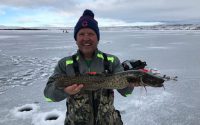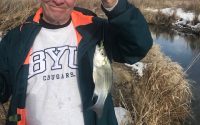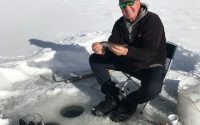On Flaming Gorge
by Don Allphin
Flaming Gorge is a fantastic fishery — perhaps the finest Utah has to offer. But wildlife biologists such as Ryan Mosley of the Utah Division of Wildlife Resources, in conjunction with his counterparts on the Wyoming side of the state line, are truly walking a tight rope. While taking a few hours to show me how to catch some “pup” lake trout through the ice last Saturday, Mosely and I spoke about the reservoir’s future.
“There is no question,” said Mosely, “that most anglers who come here during the summer months are trying to catch kokanee salmon. That means we feel some pressure to provide them a quality experience. We are attempting to increase the numbers of kokanee, but are facing some challenges as we pursue this goal. Flaming Gorge is also a trophy-class lake trout fishery and those big 25- to 40-pounders eat a lot of Kokanee salmon. So, not only do anglers target kokanee but so do lake trout.”
Adding to this complicated equation is the ever-expanding burbot population. These “freshwater cod” have, in a handful of years, spread throughout the reservoir. They are aggressive, opportunistic feeders that gorge themselves on the eggs and fry of both kokanee salmon and lake trout.
“We really don’t know what to do with the burbot,” continued Mosely. “We’d like to slow their expansion as best we can, though I’m afraid they’re here to stay. They will eat almost anything, but, there is some hope. This past season we finally found burbot in the stomachs of lake trout, which made us feel a little better. Maybe the lake trout will help anglers keep them in check.”
Meanwhile, anglers must keep and kill all burbot they catch. Anglers target burbot in the evenings and those who have become burbot specialists routinely catch several quality fish each time they take to the ice. Jigs tipped with sucker meat are among the most popular burbot baits.
“Some people wonder why we’ve raised the limit on smaller lake trout (8 fish with only one over 28 inches),” Mosely said, as he pulled a 20-incher through the ice. “Smaller lake trout are stuck in a forage bottleneck. There are too many of them to continue to grow and become trophy-quality. While they’re smaller, say under 25 inches long, they mostly eat zooplankton. But eventually, they must expand their forage in order to continue to grow. It’s one of our goals to harvest more lake trout under 25 inches so eventually some of them will break through the forage barrier and become trophies.”
Of course, if biologists succeed with the lake trout, there will be more huge fish with their eyes squarely set on eating more kokanee. And, fishery managers like Mosely realize their high wire act will most likely continue long into the future. “Not only are we trying to improve the kokanee population, we’re also stocking more rainbows,” he said. “Forage will always be a struggle for Flaming Gorge, but at the end of the day, I’m an optimist. In the meantime, this is still a great place to fish.”
Check out some photos of lake trout and burbot at www.heraldextra.com , and good luck with your fishing.











